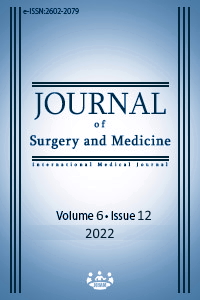Paraoxonase 1 (PON1) gene Q192R polymorphism in patients with vitiligo
PON1 Q192R gene polymorphism and vitiligo
Keywords:
Vitiligo, PON1 gene Q192R, PolymorphismAbstract
Background/Aim: Vitiligo is a prevalent inflammatory illness that can affect the skin and mucosal surfaces and is characterized by patchy loss of skin pigmentation. Paraoxonase1 (PON1) is an esterase enzyme with antioxidant properties that binds to high-density lipoproteins. We examined whether the PON1 gene Q192R polymorphism is a risk factor for vitiligo among Turkish people.
Methods: The study included 70 controls and 60 vitiligo cases. Polymerase chain reaction and the restriction fragment length polymorphism technique were used to genotype the PON1 gene Q192R polymorphism.
Results: PON1 gene Q192R genotype distribution was 66.7% QQ, 33.3% QR, and 0% RR in the vitiligo and 81.4% QQ, 18.6% QR, and 0% RR in the control (P = 0.05). When vitiligo patients were compared with controls, the prevalence of the PON1 QR genotype was substantially higher and was linked to a 2.19-fold greater risk of developing vitiligo (odds ratio: 2.19, 95% confidence interval (CI): 0.97–4.91).
Conclusion: These findings imply that Q192R polymorphisms in the PON-1 gene may be linked to vitiligo in the Turkish population. The PON1 QR genotype may be a major genetic risk factor for vitiligo susceptibility and progression. Further studies with larger populations should more thoroughly clarify the association.
Downloads
References
ddha NC, Dwivedi M, Mansuri MS, Gani AR, Ansarullah M, Ramachandran AV, et al. Vitiligo: interplay between oxidative stress and immune system. Exp Dermatol. 2013 Apr;22(4):245-50. DOI: https://doi.org/10.1111/exd.12103
Taïeb A, Picardo M. Clinical practice. Vitiligo. N Engl J Med. 2009 Jan 8;360(2):160-9. DOI: https://doi.org/10.1056/NEJMcp0804388
Lu L, Liu L, Ji Y, Jin H, He L. Association of the 389 C/T polymorphism of the catalase gene with susceptibility to vitiligo: a meta-analysis. Clin Exp Dermatol. 2014 Jun;39(4):454-60. DOI: https://doi.org/10.1111/ced.12340
Birlea SA, Ahmad FJ, Uddin RM, Ahmad S, Pal SS, Begum R, et al. Association of generalized vitiligo with MHC class II loci in patients from the Indian subcontinent. J Invest Dermatol. 2013;5:1369-72. DOI: https://doi.org/10.1038/jid.2012.501
Dizen-Namdar N, Emel Kocak F, Kidir M, Sarici G, Tak H, Altuntas I. Evaluation of Serum Paraoxonase, Arylesterase, Prolidase Activities and Oxidative Stress in Patients with Alopecia Areata. Skin Pharmacol Physiol. 2019;32(2):59-64. DOI: https://doi.org/10.1159/000494690
Gürbüz Ş, Yıldız M, Kara M, Kargün K, Gürger M, Ateşçelik M, et al. Paraoxonase-1 gene in patients with chronic obstructive pulmonary disease investigation Q192R and L55M polymorphisms. World J Emerg Med. 2015;6(3):201-6. DOI: https://doi.org/10.5847/wjem.j.1920-8642.2015.03.007
Hong SH, Song J, Min WK, Kim JQ. Genetic variations of the paraoxonase gene in patients with coronary artery disease. Clin Biochem. 2001 Sep;34(6):475-81. DOI: https://doi.org/10.1016/S0009-9120(01)00257-0
Voetsch B, Benke KS, Damasceno BP, Siqueira LH, Loscalzo J. Paraoxonase 192 Gln-->Arg polymorphism: an independent risk factor for nonfatal arterial ischemic stroke among young adults. Stroke. 2002 Jun;33(6):1459-64. DOI: https://doi.org/10.1161/01.STR.0000016928.60995.BD
Öktem F, Anıl H, Sütcü R, Kuybulu AE. Genetic polymorphisms of paraoxonase1 192 and glutathione peroxidase1 197 enzymes in familial Mediterranean fever. Genet Mol Res. 2014 Apr 29;13(2):3292-300. DOI: https://doi.org/10.4238/2014.April.29.7
Spritz RA. The genetics of generalized vitiligo. Curr Dir Autoimmun. 2008;10:244-57. DOI: https://doi.org/10.1159/000131501
Costa LG, Vitalone A, Cole TB, Furlong CE. Modulation of paraoxonase (PON1) activity. Biochem Pharmacol. 2005 Feb 15;69(4):541-50. DOI: https://doi.org/10.1016/j.bcp.2004.08.027
Seçkin HY, Kalkan G, Benli I, Bütün I, Baş Y, Takçı Z, et al. Analysis of paraoxonase-1 (PON1) gene polymorphisms in vitiligo. Turkish Journal of Biochemistry. 2015;40(5): 356-62. DOI: https://doi.org/10.1515/tjb-2015-0027
Canales A, Sánchez-Muniz FJ. Paraoxonasa, ¿algo más que una enzima? [Paraoxonase, something more than an enzyme?]. Med Clin (Barc). 2003 Oct 25;121(14):537-48. DOI: https://doi.org/10.1016/S0025-7753(03)74011-1
Karakucuk S, Baskol G, Oner AO, Baskol M, Mirza E, Ustdal M. Serum paraoxonase activity is decreased in the active stage of Behçet's disease. Br J Ophthalmol. 2004 Oct;88(10):1256-8. DOI: https://doi.org/10.1136/bjo.2004.043398
Toker A, Kadi M, Yildirim AK, Aksoy H, Akçay F. Serum lipid profile paraoxonase and arylesterase activities in psoriasis. Cell Biochem Funct. 2009 Apr;27(3):176-80. DOI: https://doi.org/10.1002/cbf.1553
Sentí M, Tomás M, Fitó M, Weinbrenner T, Covas MI, Sala J, et al. Antioxidant paraoxonase 1 activity in the metabolic syndrome. J Clin Endocrinol Metab. 2003 Nov;88(11):5422-6. DOI: https://doi.org/10.1210/jc.2003-030648
Ramadan R, Tawdy A, Abdel Hay R, Rashed L, Tawfik D. The antioxidant role of paraoxonase 1 and vitamin E in three autoimmune diseases. Skin Pharmacol Physiol. 2013 Sep;26(1):2-7. DOI: https://doi.org/10.1159/000342124
Pola R, Gaetani E, Flex A, Gerardino L, Aloi F, Flore R, et al. Lack of association between Alzheimer's disease and Gln-Arg 192 Q/R polymorphism of the PON-1 gene in an Italian population. Dement Geriatr Cogn Disord. 2003;15(2):88-91. DOI: https://doi.org/10.1159/000067975
Downloads
- 376 538
Published
Issue
Section
How to Cite
License
Copyright (c) 2022 Raziye Akcilar , Nazli Dizen Namdar
This work is licensed under a Creative Commons Attribution-NonCommercial-NoDerivatives 4.0 International License.
















